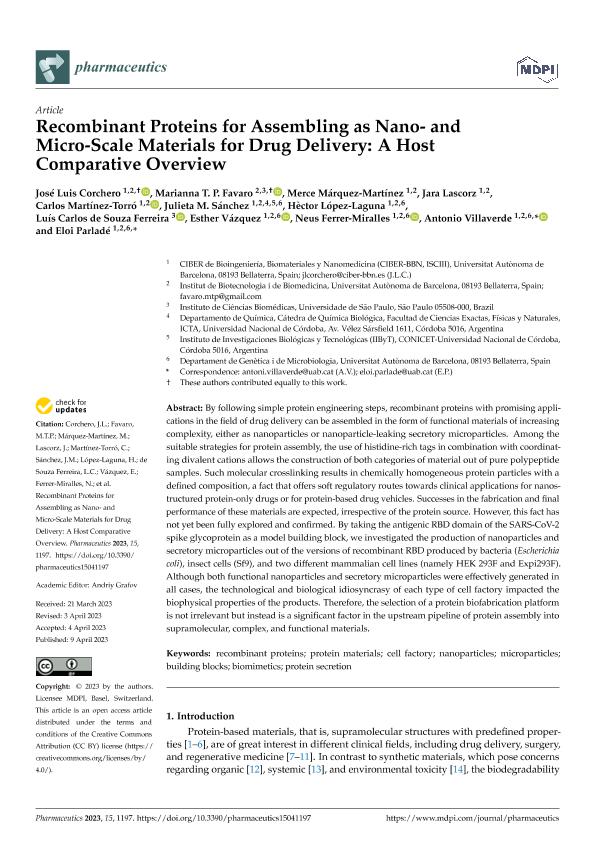Artículo
Recombinant Proteins for Assembling as Nano- and Micro-Scale Materials for Drug Delivery: A Host Comparative Overview
Corchero, José Luis; Favaro, Marianna T. P.; Márquez Martínez, Merce; Lascorz, Jara; Martínez Torró, Carlos; Sanchez, Julieta Maria ; López Laguna, Hèctor; de Souza Ferreira, Luís Carlos; Vázquez, Esther; Ferrer Miralles, Neus; Villaverde Corrales, Antonio; Parladé, Eloi
; López Laguna, Hèctor; de Souza Ferreira, Luís Carlos; Vázquez, Esther; Ferrer Miralles, Neus; Villaverde Corrales, Antonio; Parladé, Eloi
 ; López Laguna, Hèctor; de Souza Ferreira, Luís Carlos; Vázquez, Esther; Ferrer Miralles, Neus; Villaverde Corrales, Antonio; Parladé, Eloi
; López Laguna, Hèctor; de Souza Ferreira, Luís Carlos; Vázquez, Esther; Ferrer Miralles, Neus; Villaverde Corrales, Antonio; Parladé, Eloi
Fecha de publicación:
09/04/2023
Editorial:
Multidisciplinary Digital Publishing Institute (MDPI)
Revista:
Pharmaceutics
ISSN:
1999-4923
Idioma:
Inglés
Tipo de recurso:
Artículo publicado
Clasificación temática:
Resumen
By following simple protein engineering steps, recombinant proteins with promising applications in the field of drug delivery can be assembled in the form of functional materials of increasing complexity, either as nanoparticles or nanoparticle-leaking secretory microparticles. Among the suitable strategies for protein assembly, the use of histidine-rich tags in combination with coordinating divalent cations allows the construction of both categories of material out of pure polypeptide samples. Such molecular crosslinking results in chemically homogeneous protein particles with a defined composition, a fact that offers soft regulatory routes towards clinical applications for nanostructured protein-only drugs or for protein-based drug vehicles. Successes in the fabrication and final performance of these materials are expected, irrespective of the protein source. However, this fact has not yet been fully explored and confirmed. By taking the antigenic RBD domain of the SARS-CoV-2 spike glycoprotein as a model building block, we investigated the production of nanoparticles and secretory microparticles out of the versions of recombinant RBD produced by bacteria (Escherichia coli), insect cells (Sf9), and two different mammalian cell lines (namely HEK 293F and Expi293F). Although both functional nanoparticles and secretory microparticles were effectively generated in all cases, the technological and biological idiosyncrasy of each type of cell factory impacted the biophysical properties of the products. Therefore, the selection of a protein biofabrication platform is not irrelevant but instead is a significant factor in the upstream pipeline of protein assembly into supramolecular, complex, and functional materials.
Archivos asociados
Licencia
Identificadores
Colecciones
Articulos(IIBYT)
Articulos de INSTITUTO DE INVESTIGACIONES BIOLOGICAS Y TECNOLOGICAS
Articulos de INSTITUTO DE INVESTIGACIONES BIOLOGICAS Y TECNOLOGICAS
Citación
Corchero, José Luis; Favaro, Marianna T. P.; Márquez Martínez, Merce; Lascorz, Jara; Martínez Torró, Carlos; et al.; Recombinant Proteins for Assembling as Nano- and Micro-Scale Materials for Drug Delivery: A Host Comparative Overview; Multidisciplinary Digital Publishing Institute (MDPI); Pharmaceutics; 15; 4; 9-4-2023; 15041197: 1-16
Compartir
Altmétricas



